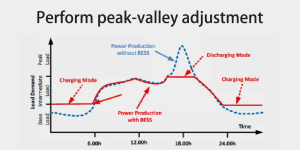What exactly is LiFePO4 BMS?
Any Lifepo4 battery system must have a BMS since it is tasked with maintaining the health and peak performance of the cells in the battery pack.
Each battery has a particular range of voltage, current, and temperature that it can work within without harm. Your battery pack may be permanently damaged (due to component deterioration) or potentially constitute a safety issue if one or more of these values considerably depart from their recommended range.
However, how can a BMS stop you from causing harm to the battery pack?
The LiFePO4 BMS manages how the battery pack is charged and discharged. Thus, the BMS protection quickly engages and modifies the charging parameters or entirely shuts off electricity to and from the battery pack if any issues arise during these procedures.
The battery cells are also monitored by the BMS to make sure they are operating properly. To maintain the health and safety of the battery, it also measures variables including voltage, current, and temperature.
The mechanism for managing lithium iron phosphate batteries' primary tasks.
- Manage working circumstances
To achieve cell balancing and avoid cell damage, measure the signals representing voltage, current, and temperature and adjust these parameters.
- Form a prognosis
Track changes from cell to cell over time, identify mistakes, spot potential dangers, and alert the driver (the driver can then take appropriate actions to avoid this safety risk).
- Data collection and storage Wolf and individual cell signals are recorded, and data about to the battery’s life cycle history is stored.
- Estimated variables
Contact controllers to establish communication for cell balancing, also assessing the state of the pack and the cells, such as state of charge (SOC) and state of health (SOH).

Various lithium iron phosphate battery management systems.
There are numerous LiFePO4 BMS available, and they vary in size depending on the size of your LiFePO4 battery.
Some are nothing more than exposed circuit boards with all electronics:
Instead, some develop from the need to shield the BMS from outside influences. They may be dustproof, fireproof, and waterproof.
Also, some alternatives have Bluetooth modules that let you manage and keep an eye on the battery using an app on your phone.
How is LiFePO4 BMS functional?
The LiFePO4 BMS is made up of a number of hardware and software functional blocks that have been programmed with tasks for monitoring and controlling the battery pack’s charging and discharging circumstances in order to protect it.
A strong BMS should offer defense against:
Under- and overvoltages.
Cellular imbalance with over- and under-currents.
Under and overheated temperatures.
Cut-off voltage and current
The battery management system comprises transistors that cut off power going from the charger to the battery or from the battery to the load based on current and voltage.
These transistors serve as switches, and they turn off to safeguard the battery from overvoltage when the battery voltage monitor detects a voltage that is higher than what the system can manage.
Cell equilibrium
The LiFePO4 BMS’s main job also includes making sure the battery pack’s cells are well balanced.
When cells are balanced, their voltage readings would be same if you measured the voltage of each one separately. This aids in preventing inconsistent charging and discharging of the battery.
The BMS adjusts the charge current of one or more of the battery pack’s individual cells so that it deviates from the pack current by one of the following:
In order to avoid overcharging and to allow less charged batteries to receive more charging current, the most charged battery must be discharged. This creates “headroom” for extra charging current.
Allows fewer charged cells to receive charge current for a longer amount of time until cell balance is reached by rerouting charge current (either totally or partially) to less charged cells.
Temperature control
The temperature sensor sends the BMS monitoring unit a signal indicating the battery’s temperature. The BMS immediately shuts off all power to the battery if a potentially hazardous charging or discharging temperature is discovered, eliminating any safety issues brought on by overheating or undertemperature.
The BMS has many protection measures coded in; the majority is too complicated to list. In order to protect the batteries from any conceivable extreme voltage, current, temperature, short circuit, cell imbalance, etc. You can improve battery performance and longevity with BMS.

Is a LiFePO4 battery capable of charging without a BMS?
Yes, LiFePO4 batteries may be charged without a BMS. However, doing so has the potential to be harmful and is not advised.
Thermal runaway, which can result in fire or explosion, can be brought on by providing a battery pack with a charging voltage or current that is higher than is advised.
If you decide to charge a LiFePO4 battery, you should, at the at least, be very careful to observe the charging parameters, such as voltage, current, and temperature (or any battery). Voltage and current meters, as well as temperature sensors for the battery cells, can be used for this.
By doing so, you’ll be able to detect any stress on your battery and change the environment as necessary.
Also, if a BMS is not used, the battery life may suffer. As a result, it doesn’t survive as long as a BMS that guarantees ideal working conditions.
How can the right BMS be selected for a LiFePO4 battery?
LiFePO4 batteries have several benefits, however they can be very expensive. Thus, you may be considering producing your own LiFePO4.
If this is the case, it is essential to use the proper BMS for your LiFePO4 battery to guarantee the secure and reliable operation of your battery pack.
The size of the battery system, particularly its rated voltage and capacity, has a significant impact on the selection of the appropriate LiFePO4 BMS.
Look at some pertinent battery characteristics first, such as voltage, amperage, capacity, and C-rating, to better understand the criteria for choosing the right BMS for a LiFePO4 battery pack.
Voltage
The voltage in a circuit is the difference in potential between two locations (voltage is measured in volts, V).
Voltage, in other words, is the pressure or force produced by current flowing across a circuit.
A battery pack is made up of numerous individual batteries. The nominal voltage of a battery pack is dependent on the quantity of cells (and their chemistry) inside.
Nominal voltage for a single LiFePO4 cell is 3.2V. As a result, a battery pack with four LiFePO4 cells connected in series has a nominal voltage of 12.8V.
Amperage
Electrical current is measured in amps. It shows how many electrons move through a particular spot in a circuit in a specific amount of time. In other terms, it refers to how quickly electrons move through a circuit.
Battery power
Amp hours are used to measure battery capacity (mAh for small batteries). It shows the maximum current that a battery is capable of producing for an hour before the cut-off voltage of each type of battery is reached.
C-rate
Battery discharge (or charge) rate is measured in C-rate terms in relation to rated capacity.
According to a 1C rate, the discharge current will exhaust the battery completely in one hour. A battery with a 100Ah rating may therefore produce 100A for one hour at a 1C rate. It will deliver 50A for two hours if its C-rate is 0.5C, on the other hand.

How do you calculate the BMS's size?
Your battery’s ideal LiFePO4 BMS size should be one that is compatible with the LiFePO4 specification. For instance, a BMS rated for a 12V battery pack should be used.
The BMS current rating is more significant. You must calculate the maximum power (in watts) that will be pulled from the battery in order to correctly size a LiFePO4 BMS. The following are the causes:
How to compute power is as follows:
Voltage (V) x Amperage equals power (W) (A)
Consider constructing a solar system with a 2000W inverter to power an 1800W load. You are thinking about using a 100A BMS and a 12V LiFePO4 battery pack to connect to this system.
The highest power you can draw from the system is 1200W if you pull 100A from your 12V battery (the maximum your 100A BMS can safely manage).
12V times 100A equals 1200W of power.
This system won’t allow you to power any loads larger than 1200W, and your 100A BMS won’t work with the 2000W solar system you want to construct.
However if you use a 200A BMS, the system’s maximum power output rises to 2400W:
12V times 200A equals 2400W of power.
Your 2000W system now has a BMS that is compatible.
On the other hand, if your battery pack's nominal voltage is greater than 12V, a 100A BMS will allow you to dissipate more power:
For a 24-volt battery pack: Maximum power output (W) is equal to 24V times 100A.
For a 48-volt battery pack: Maximum power output (W) = 48V x 100A = 4800W
To be compatible with your battery system, this 100A BMS must be rated for the same voltage.
Using capacity and C-rate can help you assess whether a BMS is capable of managing your battery system.
For instance, the BMS should be able to manage at least 40A if you have a 200Ah battery pack with a maximum C-rate of 0.2C for a certain load because: 200Ah x 0.2C = 40A max, delivery 5 hours
Last but not least
In conclusion, pick a BMS with a charge current that is higher than the current you will use to charge the battery and a continuous discharge current that is a little bit higher than the current you will use the battery for. Always leave room for unexpected events.
Verify that it is rated for your battery setup as well: 8 cells for 8 cells, 16 cells for 16 cells, etc., are all examples of cell sizes. The number of sampling cables connecting the BMS to your batteries also reflects this (there should be one wire per battery).
Last but not least, confirm that your LiFePO4 BMS has all the features you could possibly want, including cell balancing, shockproof housing, a bluetooth module that can be controlled and programmed via an app, etc.

Conclusion
The BMS is an essential part of the battery system since it monitors the battery cells and ensures that they are working together properly inside the battery pack.
To make sure your battery is operating effectively and safely, it measures other charge and discharge characteristics as well, including voltage, current, and temperature.
The BMS will take action to address the issue, which can entail fully shutting down the battery system, if any battery starts to fail.
So, choosing the right BMS will significantly affect the life cycle and overall performance of the battery pack.











